 Gosh! Another News Flash From The Eagle Cam!
Gosh! Another News Flash From The Eagle Cam!
Wow, the eagles in Shepherdstown now have laid three eggs in the nest.Here is the latest from the NCTC.We have three eagle eggs!
The first egg was laid early morning on Thursday, February 9th --thanks to all you eagle watchers for catching the big moment. The second egg was laid on Feb 11th, during our snow storm. We spied a third egg in the nest on Thursday morning, Feb 16th. The female laid the egg sometime late Wednesday night or early Thursday morning--a full 4 days after laying egg #2.
This is a bit unusual, and we will have to keep a close eye to see if all three eggs hatch, and if they do, how the smallest eagle fares against his siblings. He will be smaller than eaglets 1 and 2.
Both eagles are taking turns sitting on the eggs, and your best chance to get a glimpse is when they switch places. Incubation lasts about 35 days, so we can expect the first eaglet to hatch on or about March 15th and the second shortly there after. They are just about on schedule with the previous two years, when she laid the first egg on Feb. 14th and 15th. Stay tuned!
 The Science Hall
The Science Hall
Yes, most of my thirty-four years of teaching was in this building – GSC’s Science Hall! The Science Hall was completed in 1943. Work on the $175,000 building had begun in August of 1941. Despite the beginning of World War II in December 1941, sufficient amounts of building materials were secured, and work on the Science Hall continued during the war. Current plans are for the construction of a new science building in the next few years.
My teaching duties included all of the zoology courses. (I also taught Parasitology, Genetics, Invertebrate and Vertebrate Zoology, Cave Biology, Entomology, Human Anatomy, Comparative Vertebrate Anatomy, Field Biology, plus other courses as needed. As you can see, teaching in a small college provides one with much experience in many areas.) The labs were often full of local live specimens. Since herpetology is a special love of mine, I kept a variety of reptiles and amphibians. What a joy it was to hear spring peepers (Pseudacris crucifer) and Wood frogs (Rana sylvatica) bursting in chorus from the lab each spring!
The specimens were a source of interest not only to our college students but were part of a touring exhibit that visited many schools in West Virginia.
Here is a photo taken many years ago of my students helping in a reptile demonstration for elementary students. They are carrying one of our Burmese pythons that were housed on second 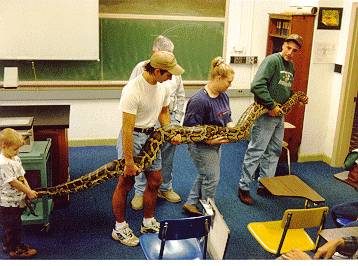 floor of the science hall.
floor of the science hall.
 History of The NCTC Eagle Cam
History of The NCTC Eagle Cam
The National Conservation Training Center eagles first showed up during the winter of 2002-03. They started working on a nest at that time, but only managed to gather a few sticks. They returned to the nest in the fall of 2003, began working on the nest in earnest. They had a large nest built by January of 2004. They laid the first egg on Valentine's Day and two eaglets were hatched by the first day of spring. Both eaglets survived and fledged in early June. The adults returned in November of 2004. They spent two months making repairs to the nest and exhibiting breeding behavior. The first egg was laid on February 15, 2005, and one eaglet hatched in late March. It survived and fledged in mid-June. The eagles are back for their third year. They arrived in November of 2005 and began nest repairs and breeding behavior. The first egg was laid on February 9, 2006. We expect it to hatch on or about March 15th . In September of 2005 NCTC installed a small video camera about 10 feet above the eagle nest allowing us a “birds-eye” view inside the nest. A local tree service company was hired to do the installation. They used their 75-foot bucket truck, but had to climb an additional 10 feet to reach the nest. The nest is about 85 feet high in a large sycamore tree, and is about 4 feet across and 2 feet deep, and probably weighs a few hundred pounds. It is made of branches and large sticks with a softer grass and leaf lining. Both eagles spend a lot of time repairing and keeping the nest strong and sturdy
The shape of the eagle nest or aerie is determined mainly by the branch point on which it is built in. Sticks placed in deep, near vertical forks result in cylindrical or conical nests. Nests built on the ground or nearly level branches are disk shaped. Bowl-shaped nests may occur where the tree trunk branches suddenly into several smaller, upright branches.Bald eagles build their nests in large trees near rivers or coasts. A typical nest is around 5 feet in diameter. Eagles often use the same nest year after year. Over the years, some nests become enormous, as much as 9 feet in diameter, weighing two tons. Even when a nest tree falls or a strong wind blows a nest down, the established pair usually rebuilds at or near the site within a few weeks if it is near the breeding season. The nest may be built in a tree, on a cliff, or even on the ground if there are no other options available
An eagle reaches sexual maturity at around four or five years of age. At that time, the eagle's energies become concentrated on the effort of finding a mate and raising offspring. Bald eagles mate for life, but when one dies, the survivor will not hesitate to accept a new mate. During breeding season, both birds protect the nest territory from other eagles and predators.
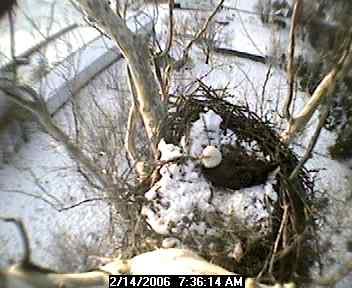 BULLETIN FROM THE EAGLE CAM!Happy Valentine’s Day! We have two eagle eggs! The first egg was laid early morning on Thursday, February 9th . The second egg was laid on Feb 11th, during our snow storm. Both eagles are taking turns sitting on the eggs, and your best chance to get a glimpse is when they switch places. Incubation lasts about 35 days, so we can expect the first eaglet to hatch on or about March 15th and the second shortly there after. They are just about on schedule with the previous two years, when she laid the first egg on Feb. 14th and 15th. Stay tuned!
BULLETIN FROM THE EAGLE CAM!Happy Valentine’s Day! We have two eagle eggs! The first egg was laid early morning on Thursday, February 9th . The second egg was laid on Feb 11th, during our snow storm. Both eagles are taking turns sitting on the eggs, and your best chance to get a glimpse is when they switch places. Incubation lasts about 35 days, so we can expect the first eaglet to hatch on or about March 15th and the second shortly there after. They are just about on schedule with the previous two years, when she laid the first egg on Feb. 14th and 15th. Stay tuned!
http://training.fws.gov/eagle/
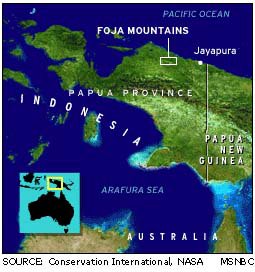 A Biologists Dream!Yesterday MSNBS reported the discovery of a plethora of new species found in the remote old growth tropical forests of Papua New Guinea. It would be super to be able to be part of this research group! Below are some excerpts from the MSNBC website posted on February 07, 2006.
A Biologists Dream!Yesterday MSNBS reported the discovery of a plethora of new species found in the remote old growth tropical forests of Papua New Guinea. It would be super to be able to be part of this research group! Below are some excerpts from the MSNBC website posted on February 07, 2006.
JAKARTA, Indonesia - Describing it as the discovery of a “Lost World,” conservation groups on Tuesday said an expedition to one of Asia’s most isolated jungles had found several dozen new species of frogs, butterflies, flowers and birds.
“It’s as close to the Garden of Eden as you’re going to find on Earth,” Bruce Beehler, a Conservation International scientist who led the expedition, said in a statement.
The team of U.S., Indonesian and Australian scientists ventured into the Foja Mountains of Papua province last December. The remote area covers more than two million acres of old growth tropical forest.
One of the most remarkable discoveries was the Golden-mantled Tree Kangaroo, an arboreal jungle-dweller new for Indonesia and previously thought to have been hunted to near extinction.
Among the discoveries was a new species of the honeyeater bird. The first new bird discovered on New Guinea since 1939, it has a bright orange face patch.
The team captured the first photos of a male Berlepsch’s Six-Wired Bird of Paradise, named for the wires that extend from its head in place of a crest.
“Amazed scientists watched as a male Berlepsch’s bird of paradise performed a mating dance for an attending female in the field camp,” Conservation International said. “This was the first time a live male of the species had been observed by Western scientists, and proved that the Foja Mountains was the species’ true home.”
The bird had been the focus of several earlier expeditions that failed to find its home.
“Other discoveries included what may be the largest rhododendron flower on record — almost six inches across — along with more than 20 new frogs and four new butterflies,” Conservation International said.
Below is the first photographic record of the Berlepsch's six-wired "lost" bird of paradise (Image: Bruce Beehler) 
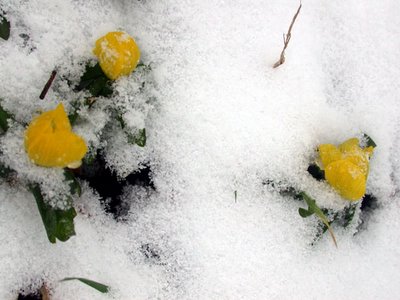 Aconites and Arafat
Aconites and Arafat
What a difference twenty-four hours makes at this season! Yes, the snow did arrive and the aconites have now curled their petals under the snow layer. Their small, simple, pretty flowers appear charming and cheerful, but this is little more than a delusive façade hiding their dark secret.
Winter aconites are one of the most poisonous plants in cultivation in gardens. This doesn’t detract from their attraction as useful winter flowering plants, but their toxic qualities have caused several fatalities throughout the centuries. Greek classical literature records the use of winter aconite poison. The famously poisonous bulbs have been used in the past as a recognized method of killing wolves.
The article below even suggests that aconite poisoning caused Yasser Arafat’s death.
British intelligence: Arafat poisonedNov 28, 2004, 13:40London- The late PA chief Yasser Arafat was poisoned with a widely known toxic substance termed as “Acontine”, which is usually extracted from an Asian plant called “Aconite”, a report, issued recently by the British intelligence, disclosed.The report said that the same substance, which could instantly dissolve in liquids, couldn’t be forensically detected in human body 12 hours after its penetration into it.The same poison causes fatal symptoms in the blood circulation, nervous, and digestive systems, according to the report.It’s probable that Arafat was gradually poisoned, as 3 to 5 mgs of that poison is enough to cause his death, it highlighted, and noted that one of his top aides might have sneaked such a substance into his meals during the holy month of Ramadan, causing his slow death as was the case with the former Algerian president Hawari Boumaddine.Well-informed Palestinian sources, meanwhile, revealed that the US administration had refused to receive Arafat at “Mayo Clinic” hospital, as his illness coincided with the holding of the US presidential elections.The administration had already been acquainted with the nature of Arafat’s disease, therefore, it declined to receive him at that hospital so as not be embarrassed by his death, according to the sources.

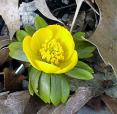 The Aconites Are Here!
The Aconites Are Here!
In Gilmer County (across the street in our neighbor’s yard), the aconites are blooming. Our friends have a great colony of these in front of their house. It is a great place to plant them – close to the house so that one can observe the colorful display. It is a welcome relief from the dullness of winter.
Aconites are one of the earliest of our spring flowering bulbs to flower, and they can be sometimes seen blooming in the snow. Members of the buttercup family, they are very easy to grow in sun or part shade, reaching only 3-5 inches tall.
Blooming time is February and March with bright golden-yellow cup shaped flowers. The flowers consist of showy sepals surrounding small, nectar-producing petals and are borne one per stem. Their leaves are deeply divided with one dissected leaf just below the flower almost like a frilled collar.
The weather service is forecasting for tonight-cold temperatures and snow. These bright yellow blooms indicate that the snowdrops and crocuses cannot be far away.
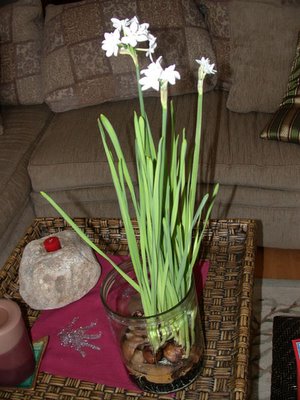 Welcome to February! Here is a bouquet in our living room that, hopefully, will remind you that the spring flowers will be here soon!
Welcome to February! Here is a bouquet in our living room that, hopefully, will remind you that the spring flowers will be here soon!
Since this fall, we have been forcing the bulbs of paper whites. Paper whites (Narcissus papyraceus ) produce pure white flowers while some varieties have white outer petals and pale yellow center cups. These plants come from the Mediterranean and fill a room with a sweet smell. This odor is quite pleasant and is very different from the rotting flesh smell of Amorphophallus. (See the last three blogs below)
As we cycled through the winter season, a great way to celebrate the approaching spring season has been to watch the blooming of these wonderful plants! Paper whites are bulb plants that can be coaxed into bloom with very little effort. Many bulbs can be forced--grape hyacinths, tulips, daffodils, and crocuses, for example--but paper whites are probably the easiest as they don't require a long cold storage period to root. I have been placing the plant bulbs in a container with only gravel and water and they have bloomed profusely.
















